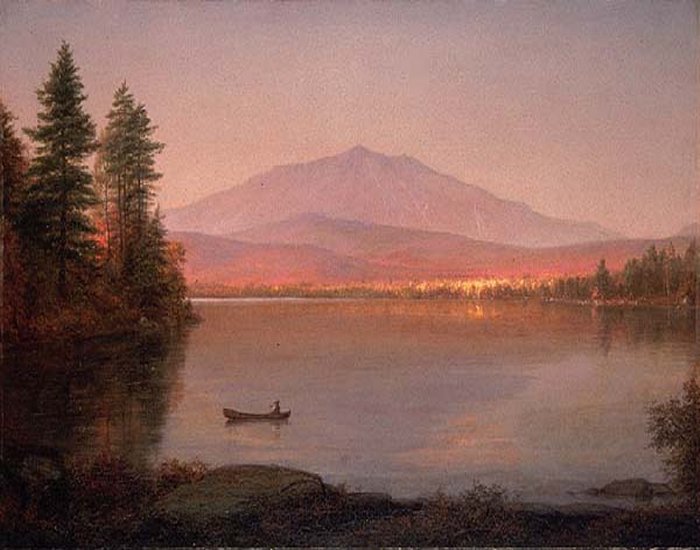A. Sutherland - AncientPages.com - Pamola is a snowbird spirit in the mythology of Abenaki (Penobscot), indigenous peoples in the northeastern United States and Eastern Canada.
In ancient beliefs of these people, Pamola (means: "he curses on the mountain") is said to be the God of Thunder and guardian of Mt Katahdin (“The Greatest Mountain”), the highest mountain in the U.S. state of Maine at 5,267 feet (1,605 m).
The bird-like creature lived on the summit of Katahdin and was responsible for cold weather.
Thunderbird – Common Motif In Stories Of Native Americans
The thunderbird is a large, avian creature widely known and worshiped among the indigenous people of North America. Numerous stories tell of a gigantic bird that makes the sound of thunder by beating its vast, strong wings. This legendary bird, most commonly found in the folklore of Arizona in the southwestern United States and a close relative to the Phoenix, could create storms.
Sheet lightning is said to be the bird blinking, and glowing snakes make lightning bolts that the bird carries around.
The thunderbird is often described as having horns and even teeth within its beak.
Worshiped And Feared By Penobscot People
The Penobscot people also have their thunderbird. The creature is known as Pamola (also spelled Bemola or Pomola). It is described as having a man's body and a moose's head. In some legends, Pamola’s head is as large as four horses and an eagle's mighty wings and feet.
In another oral tradition, Pamola was the storm-bird with mighty wings, a head as large as four horses, and horrible beaks and claws. The legendary bird was associated with snow, night, wind, and storms. It was not a creature any human being would want to mess with.
Mount Katahdin from Millinocket Camp, by Frederic Edwin Church, 1895. Credit: Public Domain
As Katahdin was the abode of Pamola, the Natives avoided climbing the mountain and considered this activity taboo. When people heard a noise like the whistling of a mighty wind, they knew that Pamola was flying not far from them. The bird was both feared and respected by the Penobscot people.
There was a belief that the spirit disliked mortals interfering from down below. As Henry David Thoreau (1817 - 1862), an American philosopher, essayist, poet, and historian, who explored Mt. Katahdin and the beliefs of the Penobscot Indians of Maine, wrote, "Pamola is always angry with those who climb to the summit of Katahdin..."
In Algonquian myth, the legendary bird Pamola is an evil spirit eventually conquered by Glooskap, a trickster god and a mythic hero.
Doomed Interactions With Terrifying Pamola
One story is about a man who went to the forests at the foot of the sacred Mt. Katahdin and was caught in a heavy snowstorm. The only he could do was to appease Pamola; he burned offerings of oil and fat until the god of thunder himself appeared to take the offerings. Surprisingly, Pamola was not angry. He thanked the man for his respect and generosity and took him to his sacred abode inside Mt. Katahdin, where he lived comfortably with Pamola’s family. He even married Pamola’s daughter but on one condition: he was not allowed to marry anyone else, or he would be taken prisoner inside Mt. Katahdin for good. Unfortunately, the man didn’t heed the warning when returning to his tribe. He disappeared, and no one ever saw him again.
Another story tells about a woman who constantly refused to believe even in the existence of Pamola unless she witnessed him with her own eyes. One day, she was on the shores of the lake of Amboctictus, near Mt. Katahdin, on the southwest side. Pamola appeared and took the woman to his home inside Mt. Katahdin. She stayed with him there for a year and was well treated, but powerful Pamola made her pregnant. Then she left his abode and returned to her home with Pamola’s son.
Pamola warned her to never re-marry and of their son’s supernatural and frightening power. The child could point at any living thing with his right forefinger, and it would die instantly.
He advised the woman to keep their son apart from society till the age of manhood, but her fellow villagers wanted her to remarry. She refused to explain that Pamola was her husband and, in case of marriage, she and the child would be taken back to Mt. Katahdin. No one took her words seriously, and soon she was re-married. Still, on the evening of her marriage day, when all the Indians from her village gathered together to celebrate the marriage, she and the child vanished forever.
Updated on July 5, 2022
Written by – A. Sutherland - AncientPages.com Senior Staff Writer
Copyright © AncientPages.com All rights reserved. This material may not be published, broadcast, rewritten or redistributed in whole or part without the express written permission of AncientPages.com
Expand for referencesReferences:
Vetromile E. The Abnakis and Their History
Cassidy D. Marsden Hartley: Race, Region, and Nation
Fee R. Ch, Webb B. J. American Myths, Legends, and Tall Tales







